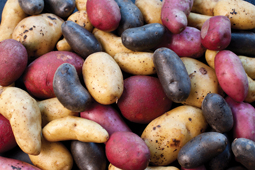Production
While Idaho is the nation’s leading potato-producing state, Washington produces the highest per-acre yield of potatoes, with an average of 87 percent being sold for processing. Southeastern Washington and Skagit County in the northern part of the state are also major potato producers, for several popular russet varieties including the Burbank, Norkotah, and Ranger, as well as chipping potatoes and reds, yellows, and blues.
Dry Washington summers necessitate the use of irrigation. To reduce disease, Evergreen State farmers generally leave each potato field fallow for three out of every four growing seasons. Washington potato planting begins at the end of February and continues through early May.
In Oregon, potato production is prominent in Blue Mountain, Central Oregon, Klamath, Malheur, and Willamette Valley. While low rainfall in southeast Oregon makes growing many other crops a challenge, potatoes require less water overall and can thrive in these areas.
Three-quarters of Oregon potatoes are sold for processing, and the Beaver State produces a quarter of the nation’s French fry exports. Top varieties include the ever-popular Burbanks, Norkotahs, Rangers, and the Shepody (the latter two for processing), the Atlantic (primarily a chipping potato), and the La Soda, Yukon Gold, and Dark Red Norland (all fresh market potatoes).
Northern Plains
Ranking third in potato production nationwide, the northern plains (North Dakota and Minnesota) is a crucial region for spuds, particularly the Red River Valley. The region produces high volumes of chipping, processing, fresh market, and seed potatoes.
The valley, created by a glacial lake, boasts flat land and rich black soil superb for growing potatoes. This soil reduces or eliminates the need for irrigation. However, Mike Rerick, vice president of sales and marketing at NoKota Packers, Inc. in Buxton ND, points out that this increases valley growers’ reliance on favorable weather conditions: regular, intermittent rains that provide the spuds with just enough moisture. “In a perfect world, you’d have nice rains a couple times a week and then go from there,” Rerick explains. “Mother Nature really plays a big part. In an irrigated region, you’re able to control the water, but not here.”
Planting usually takes place throughout the month of May, sometimes continuing into June, and Red River Valley potatoes are typically harvested between September and November. A hotline hosted by North Dakota State University provides forecast information that helps growers anticipate and minimize the risk of late blight, as well as providing current information on other pest and disease threats.



